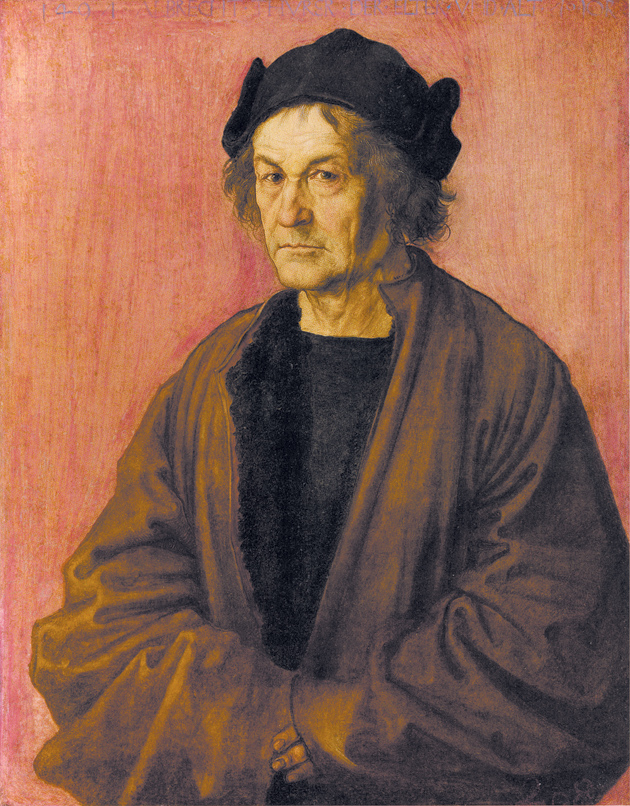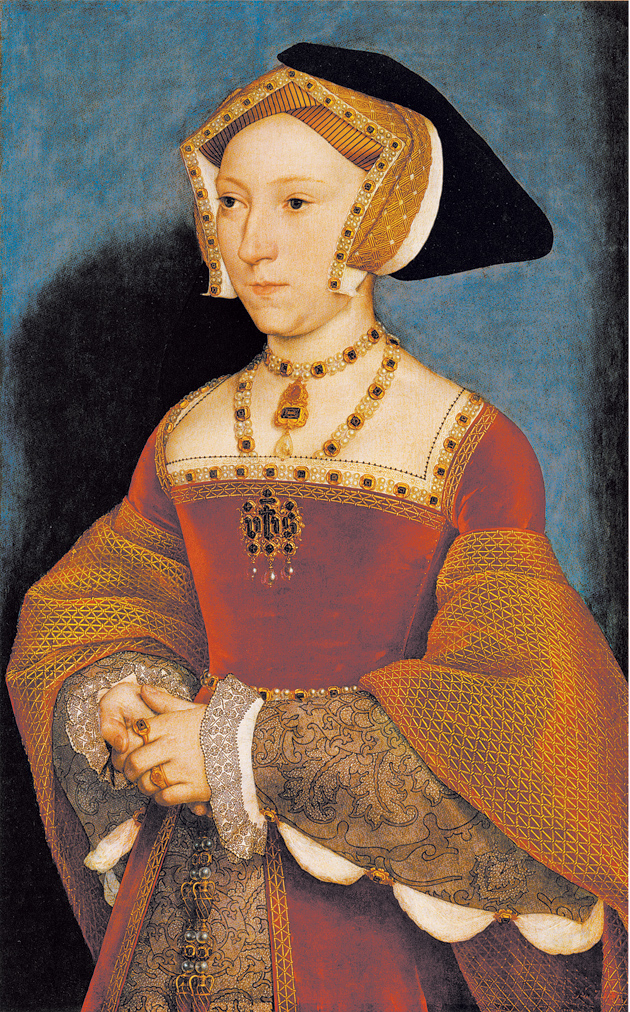The birth of the portrait at the dawn of modern society was much more than a mere event in the history of art. It stimulated the self-representation of emperors, kings, and princes and changed the way the rich and famous satisfied their craving for recognition. In painted panels that captured the appearance of a person as in a mirror, in etchings and woodcuts that allowed multiple reproductions of the portrait to be sent abroad, the likenesses of distinguished personalities could overcome the constraints of place, time, mortality, and oblivion. Rulers became ubiquitously present through their widespread likenesses, as shown by the example of the early-sixteenth-century Holy Roman Emperor Maximilian I. Scholars like Maximilian’s contemporary Erasmus of Rotterdam distributed their portraits to contemporaries and willed them to posterity to ensure their lasting fame.
Thus the desire for portraits is closely related to the fear of the end of life and the loss of status. This fear is inscribed in the portraits of the humanists. Beneath Albrecht Dürer’s imposing portrait of his friend Willibald Pirckheimer we read, “We live on in Spirit, the rest is subject to Death.” In his Primer of Painting Dürer writes, “The art of painting preserves the figure of the subject after his death.” Thus, although the rise of portraiture did not lead to “the discovery of man” as the title of this exhibition and many other texts claim, it did expand the means of societal communication and create a new public visibility for the distinguished and well-to-do.
As in banking and humanistic studies, Italy also led the way in the rise of portraiture, with Florence and Venice as its main focal points. A splendid show, currently to be seen in Berlin and later at the Metropolitan Museum, displays Italian Renaissance portraiture from Donatello to Bellini. It presents an exquisite selection of paintings, drawings, and sculptures from Florence, the Italian Courts, and Venice. The proud portraits, busts, and medals of Florentine bankers and humanists are shown along with the sophisticated likenesses from the courts at Ferrara, Mantua, and Urbino. It seems no exaggeration to say that Italian portraits from the age of humanism, as well as Venetian portraits, with their dreaminess or saturated opulence, have never before been exhibited with such intelligence and richness.* At the same time, a more intimate kind of portrait blossomed in the Low Countries around the Burgundian court and in wealthy mercantile cities like Bruges and Ghent. Here, the subject is portrayed with more indulgence, often in an interior, next to a window, as in Jan van Eyck’s fifteenth-century Arnolfini Portrait (now in London’s National Gallery).
Not long afterward, demand for portraits arose in Germany as well, both in its numerous principalities and among the bourgeois inhabitants of the imperial cities directly under the authority of the emperor. In some of these works an idiosyncratic curiosity about physiognomy at times led to odd and quirky extremes. But with Dürer and Hans Holbein the Younger, German portrait painting attained a level that need not fear comparison with the Netherlandish and even the Italian masters of the genre.
The Kunsthalle of the Hypo Cultural Foundation in Munich has made German portraiture around 1500 the theme of a comprehensive exhibit. In eight galleries it brings together not just paintings, but also drawings, etchings, woodcuts, sculptures, and medals. The social spectrum runs from the emperor and the aristocracy to princes of the church, from court officials to reformers and humanists. The portrait is a function of class, however: artisans are barely in evidence, to say nothing of even lower social strata. A frightening exception is a cheap woodcut showing the glowering likeness of a rapist who was put to death in 1540. This broadsheet demonstrates that the new medium could also be used to produce multiple copies of an image intended for public denunciation.
The panorama of portraits gazing down from the colorful walls of the exhibition rooms (often somewhat pretentiously covered in damask) presents a physiognomic and social diversity not easy to assimilate all at once. In fact, there’s more than art going on here. This show is a mirror of the conditions in Germany from the eve of the Reformation to the Peace of Augsburg, the mid-sixteenth-century treaty that effectively divided Germany into the Lutheran north and the Catholic south.
Artistically speaking, Dürer and the younger Holbein are the stars of the show. Dürer liberated the German portrait from its late Gothic inhibitions and brought it into the new era. Holbein had to cater to the demands of the English court for displays of status far beyond anything he had encountered on the Continent. The show contains major works by both artists that in themselves make a visit worthwhile.
Advertisement
The impressive series of Dürer works begins with the portrait of his father. The original inscription read, “1497. I painted this image of my father as he appeared in his seventieth year.” We see the weathered face of an old man, portrayed by his son with attentive veneration. Hardly any other portrait equals this work’s grave and silent attempt to arrest mortality. There is, however, another panel here that lovingly, ruthlessly reveals the marks and the degeneration of old age. Having become famous in the following years, Dürer painted his eighty-two-year-old teacher Wolgemut in 1516. Two years earlier, he had drawn a well-known portrait of his mother that is not part of this show. In all three works, there is interplay between their subjects and death.
Dürer’s fame would soon lead to his employment as the portraitist of the rich and powerful. When the Reichstag met in Augsburg in 1518 he painted Emperor Maximilian I. Although the portrait is not in the show, his woodcut of Maximilian is a likeness that was reproduced and distributed innumerable times. Probably at the same Reichstag, Jakob Fugger the Wealthy also had Dürer paint his portrait. The icy, uncommunicative face beneath a golden toque exudes a coldness that makes the viewer shiver. The Augsburg banker with his legendary wealth is represented several times in the show—in a 1498 wedding portrait dripping with gold; an impressive 1511 woodcut by Hans Burgkmair the Elder; and a coin by Hanns Schwarz showing Mercury on the reverse. The financier and social climber with business connections throughout the world was not immune to the desire for likenesses of himself.
Other Dürer portraits lead us to Nuremberg’s patrician class. At the beginning of the show stands the austere, suspenseful portrait of Elsbeth Tucher from 1498. A comparison with the portrait of a Venetian woman Dürer painted seven years later shows how Dürer’s experience of the sensuality of Venice transformed his art. But to return to the Nuremberg patricians: in 1526 Dürer celebrated the senatorial dignity of one of the highest officials of the imperial city in the portrait of his friend Jakob Muffel. The same year he painted the much-traveled Johannes Kleberger as a bust all’antica stripped of all Gothic coziness. The artist also designed the medal that the obviously vain Kleberger had made by Mathes Gebel, to be found in the show as well.
Around 1520, Dürer discovered in copper engraving a new form for the humanistic portrait: the bust of the sitter appears above a panel with a Latin inscription. In these prints we see figures from the history of the incipient Reformation: the rich Cardinal Albrecht von Brandenburg, the charming and intellectual face of the theologian Melanchthon, and the bearded Friedrich the Wise, the Elector of Saxony and protector of Luther, with the lovely inscription “He was with great piety devoted to the Word of God.” One comes across Friedrich the Wise again in an unexpected place: in the interior of a walnut box whose lid shows a centaur. Here the portrait of the prince, no longer on public display, becomes part of a private amorous game.
The contrast between the urbane imperial portraitist and humanist Dürer and the English court painter Holbein could not be greater. The works of Holbein on display here have an incomparable virtuosity. The series begins with a dashing portrait from his early years in Basel. His painting of Jane Seymour, the third wife of Henry VIII, is probably the most brilliant work in the entire show. Yet beneath the costly dress, beneath the red, the gold thread, and the jewels, the impeccably rendered Seymour remains without sharply distinctive character. Precisely therein, however, resides the genius of Holbein as a court painter: his likeness betrays nothing. The portraits that follow, however, show us another Holbein. The picture of the king’s personal physician John Chambers, portrayed at an advanced age, is moving in its weary, skeptical humanity. The high point is the large portrait of the French ambassador to the London court Charles de Solier, Sieur de Morette. Here we stand before a portrait whose imperious power is the equal of Titian’s portrait of Pietro Aretino.
Lukas Cranach, the third artist featured in the show, lacks the stature of Dürer and Holbein. Moreover, the best portraits of his early career are not included. Nevertheless, there are some excellent pictures of the nobility, including the childhood magic in the portraits of the princes Moritz and Severin of Saxony. On the other hand, the well-known princesses from the 1530s in their colorful costumes seem overdressed next to Holbein’s Jane Seymour. The strength and character of German portraits lie not in elegance or details of dress, but in the individualism of faces not smoothed into uniformity.
Advertisement
The exhibit culminates in the central gallery with full-length portraits of princes. The German master of such pictures—perhaps even their inventor—was the ennobled Jakob Seisenegger. Next to his famous but somewhat dull portrait of the emperor there are the striking likenesses of Archduke Ferdinand of Tyrol and Archduchess Anna in a glorious silver-white silk dress. The Munich court, not wanting to be left behind, had Hans Mielich portray Duke Albrecht V and his Habsburg bride Anna in full figure, a bit stiff, but richly costumed. For a moment viewers can forget that they are at an exhibition and imagine themselves standing in the grand hall of a palace. But Mielich also painted Albrecht’s predecessor Wilhelm IV on his deathbed, his sunken face scored by suffering and stripped of courtly decorum. With all their vanity and pretentions to influence and power, these old portraits are always inscribed with transience and death.
-
*
“Gesichter der Renaissance: Meisterwerke italienischer Portrait-Kunst,” an exhibition at the Staatliche Museen in Berlin, August 20–November 20, 2011, and at the Metropolitan Museum of Art, New York City, December 21, 2011–March 18, 2012. The title of the New York exhibition will be “The Renaissance Portrait from Donatello to Bellini.” ↩





